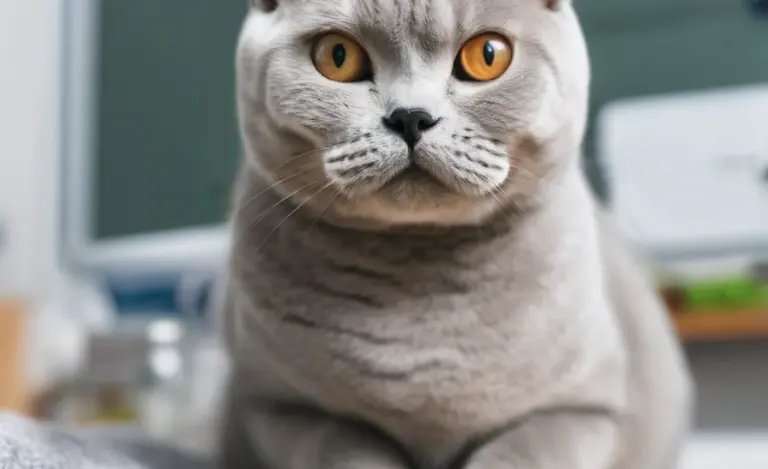How to Prevent Dry Paws in British Shorthairs: Easy Guide
To prevent dry paws in your British Shorthair, regularly moisturize with pet-safe balms, ensure proper hydration through fresh water and a balanced diet, and maintain a clean environment free from harsh chemicals. Using humidifiers during dry seasons and providing soft bedding also helps keep their paws healthy and comfortable. Consistent paw care is essential for your cat’s overall well-being!
Hello, fellow British Shorthair lovers! Have you ever noticed your beloved kitty’s paws feeling a bit rough? Dry paws are a common issue, and it can be uncomfortable for your feline friend. Just like our hands, a cat’s paws can get dry and cracked, leading to irritation.
But don’t worry! Preventing dry paws is easier than you might think. In this guide, I’ll walk you through simple steps to keep those adorable paws soft and healthy. We’ll cover everything from moisturizing tips to environmental adjustments, ensuring your British Shorthair stays happy and comfortable. Ready to pamper those paws? Let’s get started!
Why Do British Shorthairs Get Dry Paws?

Understanding why your British Shorthair gets dry paws is the first step in preventing it. Several factors can contribute to this common issue. Let’s explore the main causes:
- Dry Air: Just like our skin, a cat’s paws can dry out in low humidity. Winter months, when heaters are running, are particularly harsh.
- Harsh Surfaces: Walking on rough surfaces like concrete or gravel can wear down the natural oils on their paws.
- Chemical Exposure: Household cleaners, detergents, and even some cat litters can irritate and dry out paw pads.
- Dehydration: Insufficient water intake can lead to overall dryness, including the paws.
- Age: Older cats may produce less natural oil, making their paws more prone to dryness.
- Underlying Health Conditions: In rare cases, dry paws can be a symptom of a more serious health issue, such as allergies or autoimmune diseases.
By understanding these factors, you can take targeted steps to protect your British Shorthair’s paws. Now, let’s dive into practical tips to keep those paws in tip-top shape!
Step-by-Step Guide to Preventing Dry Paws

Here’s a detailed guide to help you prevent dry paws in your British Shorthair. Follow these steps to keep your cat comfortable and healthy.
Step 1: Moisturize Regularly
Just like we use lotion on our hands, your cat’s paws can benefit from regular moisturizing.
- Choose a Pet-Safe Balm: Look for balms specifically designed for pets. These are non-toxic and safe if your cat licks their paws. Avoid human lotions, as they may contain ingredients harmful to cats.
- Apply After Baths: After bathing your British Shorthair, gently pat their paws dry and apply a small amount of balm. This helps to lock in moisture.
- Daily Application: In dry environments, consider applying balm daily, especially before bedtime. This allows the balm to soak in overnight.
- Recommended Products: Consider brands like Musher’s Secret Paw Protection or Burt’s Bees Paw & Nose Lotion for Cats. Always read reviews and check ingredients to ensure they are safe for your cat.
Regular moisturizing is a simple yet effective way to combat dryness and keep your cat’s paws soft and supple.
Step 2: Ensure Proper Hydration
Hydration is key to overall health, including paw health.
- Fresh Water: Always provide fresh, clean water. Change the water at least once a day to encourage drinking.
- Multiple Water Sources: Place water bowls in multiple locations around your home. Cats often prefer different spots.
- Consider a Water Fountain: Many cats prefer running water. A pet water fountain can encourage your cat to drink more.
- Wet Food: Supplement your cat’s diet with wet food. Wet food has a higher moisture content than dry kibble, helping to keep your cat hydrated.
- Monitor Water Intake: Keep an eye on how much water your cat drinks. If you notice a sudden decrease, consult your vet.
Proper hydration is crucial for maintaining healthy skin and paws. Make sure your British Shorthair has access to plenty of fresh water throughout the day.
Step 3: Maintain a Clean Environment
A clean environment can prevent irritation and dryness.
- Gentle Cleaners: Use pet-friendly, non-toxic cleaning products. Harsh chemicals can dry out and irritate your cat’s paws.
- Avoid Irritating Litter: Choose a cat litter that is low-dust and free of harsh chemicals. Some litters can be abrasive and cause dryness.
- Regular Cleaning: Regularly clean your floors to remove dirt and debris that can irritate paws.
- Paw Cleaning Wipes: Use pet-safe paw cleaning wipes to gently clean your cat’s paws after they’ve been outside or in areas with potential irritants.
By keeping your home clean and using gentle products, you can minimize the risk of dry, irritated paws.
Step 4: Use a Humidifier
In dry climates or during winter months, a humidifier can make a big difference.
- Increase Humidity: A humidifier adds moisture to the air, which helps to prevent dry skin and paws.
- Placement: Place humidifiers in areas where your cat spends the most time, such as the living room or bedroom.
- Maintenance: Clean your humidifier regularly to prevent mold and bacteria growth. Follow the manufacturer’s instructions for cleaning.
- Monitor Humidity Levels: Aim for a humidity level between 40-60%. You can use a hygrometer to monitor the humidity in your home.
A humidifier can be a valuable tool in maintaining a comfortable and healthy environment for your British Shorthair.
Step 5: Provide Soft Bedding
Soft bedding can protect your cat’s paws from rough surfaces.
- Comfortable Beds: Provide soft, padded beds for your cat to rest on. This minimizes the amount of time they spend on hard surfaces.
- Blankets and Cushions: Place soft blankets and cushions in your cat’s favorite spots.
- Avoid Rough Materials: Choose bedding made from soft, natural materials like cotton or fleece. Avoid rough or scratchy fabrics.
- Regular Washing: Wash your cat’s bedding regularly to remove dirt and allergens.
Soft bedding not only provides comfort but also helps to protect your British Shorthair’s paws from unnecessary wear and tear.
Step 6: Trim Nails Regularly
Regular nail trimming is essential for paw health.
- Prevent Overgrowth: Overgrown nails can put pressure on the paw pads, leading to discomfort and dryness.
- Use Cat Nail Clippers: Use clippers specifically designed for cats. These are safer and more effective than human nail clippers.
- Trim Carefully: Only trim the tips of the nails to avoid cutting the quick (the pink part of the nail containing blood vessels and nerves).
- Frequency: Trim your cat’s nails every 2-3 weeks, or as needed.
- Professional Help: If you’re not comfortable trimming your cat’s nails, ask your vet or a professional groomer for assistance.
Keeping your cat’s nails trimmed will help maintain healthy paws and prevent discomfort.
Step 7: Check Paws Regularly
Regularly inspecting your cat’s paws allows you to catch issues early.
- Look for Cracks and Redness: Check for any signs of dryness, cracks, redness, or swelling.
- Feel for Roughness: Run your fingers over the paw pads to check for roughness or hardened areas.
- Check Between Toes: Look between the toes for any signs of irritation or foreign objects.
- Monitor for Limping: Watch for any signs of limping or discomfort while walking.
- Consult Your Vet: If you notice any abnormalities, consult your vet promptly.
Regular paw checks are a proactive way to ensure your British Shorthair’s paws remain healthy and comfortable.
Specific Products to Help Prevent Dry Paws

Choosing the right products can make a big difference in preventing dry paws. Here are some recommendations:
| Product Type | Recommended Brands | Why It Helps |
|---|---|---|
| Paw Balm | Musher’s Secret Paw Protection, Burt’s Bees Paw & Nose Lotion for Cats | Moisturizes and protects paw pads from dryness and cracking. |
| Humidifier | Levoit Humidifiers, Pure Enrichment MistAire Ultrasonic Cool Mist Humidifier | Adds moisture to the air, preventing dryness in the home. |
| Cat Litter | Dr. Elsey’s Precious Cat Ultra, World’s Best Cat Litter | Low-dust and free of harsh chemicals, reducing irritation. |
| Paw Cleaning Wipes | Pogi’s Pet Supplies Grooming Wipes, Earthbath All Natural Grooming Wipes | Gently cleans paws and removes irritants. |
| Water Fountain | Catit Flower Fountain, Drinkwell Platinum Pet Fountain | Encourages cats to drink more water, promoting hydration. |
These products can be valuable additions to your paw care routine, helping to keep your British Shorthair’s paws healthy and moisturized.
Dietary Considerations for Paw Health

A balanced diet plays a crucial role in maintaining overall health, including paw health.
- Omega-3 Fatty Acids: Include foods rich in omega-3 fatty acids, such as fish oil supplements. These help to keep the skin and paws moisturized.
- High-Quality Protein: Ensure your cat’s diet is rich in high-quality protein. Protein is essential for skin and paw health.
- Vitamins and Minerals: Look for cat foods that are fortified with essential vitamins and minerals, such as vitamin E and zinc.
- Avoid Allergens: If your cat has allergies, work with your vet to identify and eliminate potential allergens from their diet.
- Consult Your Vet: Always consult with your vet before making significant changes to your cat’s diet.
A nutritious diet is the foundation of good health, and it can significantly contribute to preventing dry paws.
When to See a Vet

While most cases of dry paws can be managed at home, it’s important to know when to seek veterinary care.
- Severe Cracking or Bleeding: If your cat’s paws are severely cracked or bleeding, consult your vet immediately.
- Signs of Infection: Look for signs of infection, such as redness, swelling, pus, or a foul odor.
- Limping: If your cat is limping or showing signs of pain, consult your vet.
- Changes in Behavior: If you notice any changes in your cat’s behavior, such as decreased appetite or lethargy, consult your vet.
- Underlying Health Conditions: If your cat has underlying health conditions, such as diabetes or autoimmune diseases, regular veterinary check-ups are essential.
Prompt veterinary care can prevent minor issues from becoming serious problems and ensure your British Shorthair stays healthy and comfortable.
Additional Tips for Paw Care
Here are some additional tips to help you maintain your British Shorthair’s paw health:
- Massage Paw Balm In: After applying paw balm, gently massage it into the paw pads. This helps to improve circulation and absorption.
- Avoid Hot Surfaces: During hot weather, avoid walking your cat on hot pavement or asphalt. These surfaces can burn their paws.
- Pawdicures: Consider professional pawdicures. Some groomers offer specialized paw treatments that can help to keep paws healthy and moisturized.
- Monitor Paw Pad Color: Healthy paw pads should be pink or black, depending on your cat’s breed. Changes in color can indicate an underlying health issue.
- Keep Indoor Environment Consistent: Keeping a stable temperature and humidity level in your home can help prevent dryness.
FAQ About Preventing Dry Paws in British Shorthairs
Here are some frequently asked questions about preventing dry paws in British Shorthair cats:
Q: Can I use human lotion on my cat’s paws?
A: No, you should not use human lotion on your cat’s paws. Human lotions often contain ingredients that are toxic to cats, such as fragrances, alcohol, and certain preservatives. Always use a pet-safe paw balm or lotion specifically formulated for cats.
Q: How often should I moisturize my cat’s paws?
A: The frequency of moisturizing depends on your cat’s individual needs and the environment. In dry climates or during winter months, you may need to moisturize daily. In more humid conditions, moisturizing every few days may be sufficient. Monitor your cat’s paws and adjust the frequency as needed.
Q: What are the signs of dry paws in cats?
A: Signs of dry paws in cats include cracked or rough paw pads, redness, flaking skin, and visible discomfort when walking. Your cat may also lick or chew at their paws more frequently.
Q: Can dry paws be a sign of a more serious health problem?
A: Yes, in some cases, dry paws can be a symptom of a more serious health problem, such as allergies, autoimmune diseases, or nutritional deficiencies. If you notice any other concerning symptoms, such as lethargy, decreased appetite, or changes in behavior, consult your vet.
Q: How can I encourage my cat to drink more water?
A: To encourage your cat to drink more water, provide fresh water daily, place water bowls in multiple locations, consider using a water fountain, and supplement their diet with wet food.
Q: Are certain cat litters better for preventing dry paws?
A: Yes, certain cat litters are better for preventing dry paws. Look for litters that are low-dust and free of harsh chemicals. Avoid litters that are highly absorbent, as they can draw moisture away from the paw pads.
Q: Is it normal for older cats to have drier paws?
A: Yes, it is common for older cats to have drier paws. As cats age, they may produce less natural oil, making their paws more prone to dryness. Regular moisturizing and other preventative measures can help to keep their paws healthy.
Conclusion
Taking care of your British Shorthair’s paws is an essential part of their overall health and well-being. By following these simple steps—moisturizing regularly, ensuring proper hydration, maintaining a clean environment, using a humidifier, providing soft bedding, trimming nails, and checking paws regularly—you can prevent dry paws and keep your feline friend comfortable.
Remember, consistency is key. Make paw care a regular part of your routine, and your British Shorthair will thank you with soft, healthy paws and a happy purr. And if you ever have any concerns, don’t hesitate to consult with your veterinarian. Here’s to happy, healthy paws for your beloved British Shorthair!




